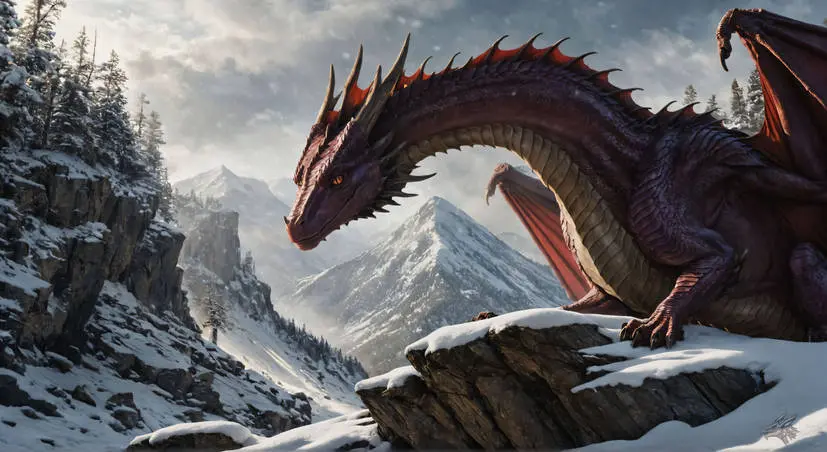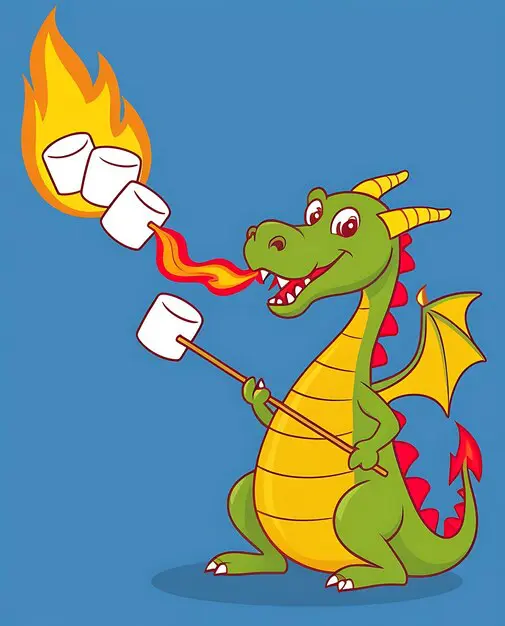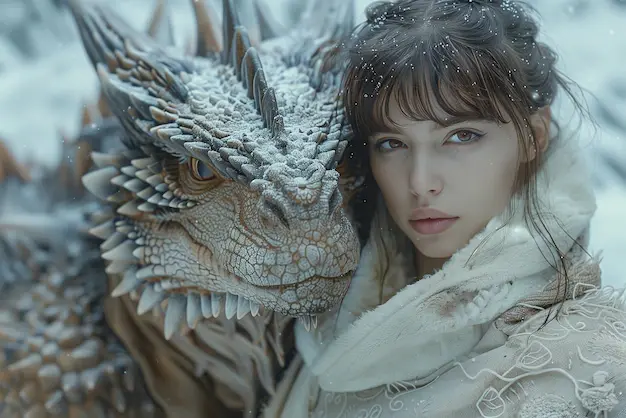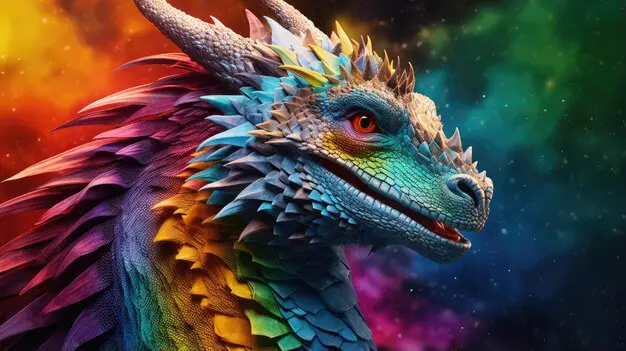Is there a Link Between Dragons and National Socialism?
ENTER THE DRAGON!
(Dragons in the Aryan Tradition)
Introduction
In Western Countries, most people’s idea of Dragons are generally a very negative, and these ideas are formed from a combination of fictional films and fictional literature. This fictional film and literature that portrays dragons negatively is of course put together by the usual Judeo-Christian suspects where the former list of suspects takes much more prominence over the later. The usual anti-Dragon suspects make dragons out to be completely imaginary, AND/OR, connected with The Devil.
In complete contrast, in East Asia, Dragons are always seen as being very benevolent beings who are revered for their wisdom, the gentleness, and longevity.

Image of a Chinese Dragon furnished courtesy of dragonwisdom.fandom.com

China has a long history of decorating gates and buildings with dragon statues, and dragons regularly appear in Chinese paintings. The image seen above shows the Bai Pu Temple near Beijing. Image courtesy of wildgreatwall.com
In stark contrast to our present Jewish ideas about dragons, our most ancient Aryan ancestors had the same feelings about dragons as East Asians. The positive relationship between The Folk and dragons only changed with FORCED conversion to Judeo-Christianity. After being initially demonized by Jews and their Judeo-Christian lackeys, dragons were made to become objects of make-believe and ridicule over time. To this day, dragons still symbolically stand for Evil and The Devil in many people’s minds. (Note: There have been indications from some official sources during the past few decades that confirmed sightings of reptilian so-called extraterrestrials have been limited to East Asia and have all been of a positive sort, although the exact connection is still unclear. Reptilian Aliens and Dragons appear in the same geographical areas, and they appear to the same ethnic groups.)
Part One – Modern European Dragons
As late as the Late 19th Century in some rural areas of the Swiss Alps, Dragons were known to exist. These great serpents lived in caves high up in the mountains and acted as local deities for some isolated farming communities across the Alps in Europe, very much like what has traditionally been the case with relations between humans and dragons in East Asia. In addition, dragons were seen as protectors of the rural Swiss farming valleys which they watched over. The old-time Swiss farmers who still saw dragons regularly were of Germanic or Germano-Celtic stock, and they still practiced old Folkish Traditions even up into the 20th century. These rural Swiss people practiced a type of Christianity that was only superficial and all for show, and this was the case for obvious reasons. If the Dragons are still present in Midgard, then they are obviously going to be dwelling in the Alpine regions of Europe; however, whether or not this is where they used to exclusively live in the old days is unclear.

Image courtesy of Feomatar-AIArt on deviantart.com
Editor’s Note:
by James Rousse
I remember reading something about Marco Polo describing dragons on his journey to China during the 1200s, and I also remember reading something about Alexander the Great encountering dragons during his military adventures in India. A quick internet search lead to a few different website which chronicled historical references to people seeing dragons. It turns out that there are a few written historical records that clearly mention dragons and these records are often very consistent.

The image above shows a painting that was made by an unknown Flemish painter during the late 1400s. The painting seen above depicts Alexander the Great battling with dragons while in India. The image above is curated at the National Library of Whales. Image courtesy of commons.wikimedia.org
For example, the website called aristrophe.com mentions a few interesting historical records of people encountering dragons. Aristrophe.com notes that the Greek historian and sophist from the third century A.D. named Flavius Flirtatious wrote detailed accounts about his sightings of dragons while he was traveling through India. Aristophe.com also mentions that rural folk around Penllyn Castle in Wales have regularly seen dragons about the area as recently as the 1960s, and a written record titled Chronicles of Johannis de Trokelowe and Henrici de Blaneforde that was penned in 1405 provides a factual account of a dragon terrorizing the English county of Suffolk. In conclusion, some notable historical accounts of encounters with dragons do exist; also, these stories of encounters with dragons are fairly consistent and long-running, so there is probably at least some truth to these old tales.
Part Two – Where Do Dragons Come From?
All that can be said for sure is that dragons are not native to Midgard, although their presence here goes back millennia until it is lost in the mists of Deep Time. Dragons are something like “Resident Aliens” by way of analogy; however, they can appear in any of the Nine Worlds. They can be exceedingly dangerous if provoked, but their natural tendency is towards peace. In spite of their fearsome appearances, dragons are not carnivorous. As legend has it, The favorite foods of dragons are plants that would be poisonous to us, such as Holly and Mistletoe.

Image courtesy of freepik.com
Part Three – The War Between Dragons and Judeo-Christianity
Dragons formed an integral and essential component of the Old Religion, and so dragons came to be viewed as synonymous with the Old Religion in the eyes of both the followers of the Old Religion and its enemies. The Old Religion of course was not only about the relations between Dragons & Men, but this special relationship was a very important part of the Old Religion.
The Story of St. George Slaying the Dragon is very illustrative of Judeo-Christianity’s relationship with dragons. As is typical for all of these Judeo-Christin stories which are told ad nauseum about the “Brave Christian Knight Slaying an Evil Dragon,” the tale of St. George features a squirrelly dragon who has been plaguing local residents and holds a fair damsel in distress. The whole story about St. George and the dragon is all about symbolism:

Orthodox Christian icons showing St. George typically picture him fighting with a dragon. The image seen above shows a Greek Orthodox icon that is for sale on athoniteusa.com
(a) The Dragon – represents the Old Religion (Heathenism/Paganism).
(b) The Damsel in Distress – represents the Christian Church.
(c) The Christian Knight – represents the forced conversion of Europeans to Christianity and the suppression of the Old Religion, which was carried out as a military operation.
So, the story of St. George slaying the dragon is about, as you have probably guessed by now, the forced conversion of Britain to Judeo-Christianity.
Part Four – Who Are The Dragons? (Being a Bestiary of the Dragons)
Dragons come in a considerable variety of types, which are roughly analogous to Human Races.
Most races of dragons have wings, but not all. There are those races of dragons that walk on the ground, and others which live in the sea aside from the much more common winged varieties.
Except for those who live in the sea, who give birth to live young, all other types of dragons lay eggs.
The vast majority times, a dragon will only lay one egg. A mother dragon will rarely lay two eggs two, and even more rarely, she will lay three. Not surprisingly, dragons are savagely protective of their eggs and their young. Dragons begin life relatively small compared to adults, but over time, they grow into huge, or even gigantic sizes, depending on the type of dragon in question. Lifespans for dragons can run into the thousands of years in many cases. Since they are more intelligent than the vast majority of humans to begin with, their long lives result in dragons becoming extremely wise when they are old.

The image above shows the “Dragons in Love” statue that rests by the oceanside in Varna, Bulgaria. The image above is provided courtesy of ANBpokeball on the r/dragons forum from reddit.com
(Information for this Part of the blog has been gleaned from many different sources within European (Mainly Celtic, German, and Germano-Celtic) Folklore since 1997. I have learned over time that Folklore is often more accurate than more Conventional History. I have known certain Professional Academic Historians to openly admit as much.)
Varieties Of Dragons
xxxxxxxxxxxxxxxxxxxx
(1) Water Dragons – These dragons are serpentine in shape and iridescent blue in color. They should not be confused with “Sea Serpents,” which are large snakelike animals which are sometimes preyed on by Sperm Whales.

Image courtesy of freepik.com
(2) Forrest Dragons – These beings are rare, and they live in the deepest primeval forests. Forest dragons and are dark green in color. These types of dragons do not have wings, but otherwise they resemble their winged cousins.

Image courtesy of freepik.com
(3) Winged Dragons – This covers the vast majority of dragon types, and these varieties of dragons are by far and away the most numerous. Winged dragons come in a wide variety of colors which defines their differing Races. Dragon races NEVER crossbreed with other dragon races. Different Races of dragons live in different places and have different habits, different collective abilities, and differing collective personalities, although they do all resemble each other in shape. All types of winged dragons live in caves.

Image courtesy of freepik.com
[a] Green Dragons – these types of dragons are more numerous than all of the other types put together and they look like the standard Dragon of the popular imagination.

Image courtesy of freepik.com
[b] Yellow Dragons – They are canary yellow in color. I have seen a baby of this variety with my own physical eyes, this is when I realized the reality of Dragons.

Image courtesy of freepik.com
[c] Red Dragons – As the name suggests, these types of dragons are cherry red in color.

Image courtesy of freepik.com

Image courtesy of Aztec-89 on the r/MandJTV on reddit.com
[d] Black Dragons – They are glossy black and live in swampy areas and bogs.

Image courtesy of freepik.com
[e] White Dragons – They are snow white in color and they blend in perfectly with their surroundings in high snowy mountains.

Image courtesy of freepik.com

Grand Dragons of the Ku Klux Klan might count as a “White Dragons.” As noted on the Bullock Museum of Texas History’s website, every state with any active Ku Klux Klan is supposed to have one Grand Dragon which is the top Klansman for that particular state.
[f] Blue Dragons – These fine beings are a medium blue in color.

Image courtesy of freepik.com

Image of the Blues Brothers furnished courtesy of vanityfair.com
{*} What follows are the types of dragons that have metallic scales. Metallic dragons are found around ore deposits of whichever metal(s) that their scales are made of.
[g] Copper Dragons
[h] Brass Dragons
[i] Gold Dragons
[j] Silver Dragons
[k] Platinum Dragons
{*} What follows is an extremely rare and special type.
[l] Rainbow Dragons – As their name suggests, rainbow dragons display every color of the rainbow. Rainbow dragons are the largest type of Dragons, and they serve as the Royalty for all of Dragonkind.
Image courtesy of freepik.com
Conclusion – The National/Racial Socialist Perspective on Dragons
As is made perfectly clear in the book “Hitler’s Table Talk,” which was compiled by Martin Borman, Hitler ultimately intended that Germany would return to the Ancient German Spiritual tradition, but in a form that is suitable for modern times, so it behooves us to reestablish the “Auld Alliance” between Dragons and Aryans in a form that is suitable for the circumstances in the 21st Century.
This blog is intended only to only as the beginning in the process of reviving the Auld Alliance between The Folk and dragons. National Socialism, as Dr. Goebbels has made so abundantly clear, has its ultimate foundations in the Blood & Soil of the German Folk (aka The Peasantry) and The German Land Itself. Dragons form an integral part of that relationship between German Folk and German Soil, so we must now strive to return to our former relationship with dragons wherever in the world we now find ourselves and in a form that is suitable for our current set of circumstances.
The Dragons are more than happy to meet our Folk halfway, indeed they are looking forward to it.
Heil Hitler deva!
-88-
Randall Lee Hilburn







